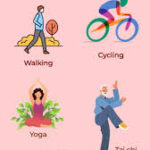Exercise for a Healthy Heart
Getting Active for a Healthier Heart: Your Complete Beginner’s Guide
Your heart is one of the most powerful muscles in your body—and like any muscle, it becomes stronger with regular use. The good news? You don’t need to be a professional athlete or hit the gym daily to boost your heart health. Even simple activities, like a brisk 30-minute walk each day, can make a big difference.
Whether you’re just starting out or looking to re-energize your fitness routine, it’s never too late to take charge of your heart health. Every step you take toward moving more is a step toward a longer, healthier life.
Why Exercise Matters for Heart Health
Physical activity plays a vital role in keeping your heart strong and efficient. Staying active improves circulation, strengthens the heart muscle, and lowers your risk of cardiovascular disease. In fact, inactive individuals are nearly twice as likely to develop heart-related conditions compared to those who are regularly active.
Key Heart-Healthy Benefits of Exercise:
- Burns calories and supports weight control
- Lowers blood pressure, easing strain on the heart
- Reduces LDL (“bad”) cholesterol levels
- Increases HDL (“good”) cholesterol, which helps clear arteries
- Enhances mood, energy, and sleep quality
Your heart doesn’t just benefit—your whole body and mind do too.
Getting Started: No Gym Required
Starting a new exercise routine can feel intimidating, but it doesn’t have to be. The most important thing is to start small and stay consistent.
Ask Yourself:
- What type of movement do I enjoy?
- Do I prefer being alone, with a group, or guided by a trainer?
- Am I more comfortable exercising at home or in a community space?
If running appeals to you but feels too intense right now, begin with walking. As your endurance builds, add short bursts of jogging. Progress at your own pace—every bit counts.
Pro Tip: If you have any existing health conditions or concerns, consult your doctor before beginning a new exercise plan.
Three Core Types of Exercise for a Stronger Heart
A balanced routine includes three main forms of exercise: cardio, strength training, and flexibility work. Together, they support overall fitness and heart health.
1. Aerobic (Cardio) Exercise
This is the most important type for heart health. It increases your heart rate, boosts lung capacity, and improves circulation.
Examples:
- Brisk walking or light jogging
- Cycling or swimming
- Dancing or hiking
- Water aerobics
Goal: Aim for a pace where you can talk, but not sing. If you’re gasping for breath, slow down.
2. Strength Training
Lifting weights or using resistance helps build lean muscle, raise your metabolism, and support bone health.
Options:
- Bodyweight exercises (e.g., push-ups, squats)
- Resistance bands
- Free weights or machines
Frequency: 2–3 times per week, with rest days in between.
3. Flexibility and Stretching
Stretching improves your range of motion and reduces the risk of injury. It also helps your muscles recover after workouts.
Focus Areas:
- Legs, hips, shoulders, and back
- Gentle post-workout stretching or yoga
Try to stretch at least 2–3 times per week, especially after cardio or strength sessions.
How Often and How Much?
Health experts recommend at least 150 minutes of moderate aerobic exercise per week—that’s about 30 minutes a day, five days a week. If you’re just getting started, break it into shorter sessions (even 10 minutes at a time works) and build up as your endurance improves.
Tip: Warm up for 5 minutes before your workout and cool down for 5 minutes after to prevent injury and help recovery.
Keep It Fun and Stay Motivated
Doing the same thing every day can get boring—and that’s when motivation fades. Keep things fresh by mixing up your activities:
- Walk on different trails
- Try a dance or fitness class
- Alternate strength workouts with swimming or biking
- Invite a friend to join you for accountability
Variety not only makes things more enjoyable but also challenges different muscle groups and prevents overuse injuries.
Know the Signs: When to Stop and Seek Help
While exercise is generally safe for most people, it’s essential to listen to your body. Stop exercising and seek medical attention if you experience:
Warning Signs:
- Chest pain or tightness
- Shortness of breath
- Dizziness or lightheadedness
- Rapid or irregular heartbeat
- Cold sweats
- Severe fatigue
These could signal a serious condition—don’t ignore them.
Mild soreness, on the other hand, is normal when you begin a new routine. It means your body is adapting and growing stronger.
Building a Habit That Lasts
Regular exercise delivers benefits far beyond physical fitness. It improves your mood, sharpens your mind, boosts your energy, and helps you sleep better.
Here’s how to make it stick:
- Set realistic goals: Start small and build gradually.
- Track your progress: Use a journal or fitness app.
- Celebrate milestones: Whether it’s your first 10,000 steps or a full workout week—reward your wins.
- Be kind to yourself: Missed a day? Just get back on track tomorrow.
Final Thoughts: A Healthier Heart Starts Today
You don’t need to be perfect to make a powerful impact on your heart health. All it takes is one step—then another.
Start where you are. Use what you have. Do what you can.
With regular movement, a little patience, and a lot of self-care, you’ll build not just a stronger heart, but a healthier, more vibrant life.
Your heart is worth it—and so are you.
Would you like this adapted for a social media carousel or email newsletter?
